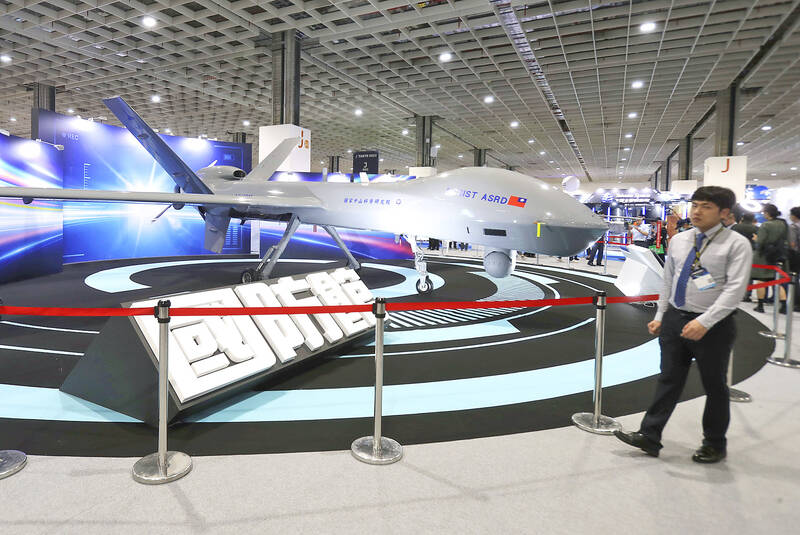After a four-year hiatus, the biennial Taiwan Aerospace & Defense Technology Expo (TADTE) opened yesterday in Taipei, with the US joining for the first time in four years.
The 16th edition of the show is the largest ever displayed, said the Taiwan External Trade Development Council (TAITRA), an organizer of the event. The expo is being held at the Taipei Nangang Exhibition Center’s Hall 1 until tomorrow.
It features about 280 exhibitors and 970 booths, along with numerous company representatives from 10 countries, TAITRA chairman James Huang (黃志芳) said.

PHOTO: AP
CEREMONY
At the opening ceremony, American Institute in Taiwan (AIT) Director Sandra Oudkirk congratulated the organizers on their historic participation in the biennial expo, which due to the COVID-19 pandemic had not been held since 2019.
“The strong turnout reflects the rapid development and growth of Taiwan’s aerospace and defense industry, as well as the growing international attention to trade and investment opportunities in the Taiwan market,” Oudkirk said in her opening remarks.
She said the AIT is hosting a pavilion at the show for the first time, in light of the two sides’ “long and robust history of partnership in the aerospace and defense sectors.”
The US features some of the biggest US industry leaders, including Lockheed Martin Corp, Northrop Grumman Corp, L3Harris Technologies Inc, Raytheon Co and BAE Systems Inc, Oudkirk said, adding that 41 small to medium-sized companies are showcasing their products.
The Prague-based Czech-Taiwanese Business Chamber, is also hosting a Czech pavilion at the three-day show for the first time, TAITRA said.
However, the main focus of this year’s exhibition, is the display by the Ministry of National Defense of more than 50 advanced weapon systems, including a new attack drone, a domestically developed jet trainer simulator and an exoskeleton suit.
SHOWCASE
The ministry’s pavilion aims to showcase the armed forces’ combat readiness, as well as reinforce self-defense awareness among Taiwanese, and boost their confidence in the nation’s military, Major General Lee Chien-ching (李健青) said at a pre-show news conference on Wednesday.
The pavilion is divided into five major areas featuring 54 items covering joint combat equipment, dual-use technology, uncrewed aerial vehicles and simulators, Lee said.
It features contributions from the US Army, Navy and Air Force, as well as the defense ministry’s Armament Bureau and the Chunshan Institute of Science and Technology, he said.
The expo is open to professional buyers on the first two days only, with the general public gaining free admission tomorrow, the organizers said.

CHIP RACE: Three years of overbroad export controls drove foreign competitors to pursue their own AI chips, and ‘cost US taxpayers billions of dollars,’ Nvidia said China has figured out the US strategy for allowing it to buy Nvidia Corp’s H200s and is rejecting the artificial intelligence (AI) chip in favor of domestically developed semiconductors, White House AI adviser David Sacks said, citing news reports. US President Donald Trump on Monday said that he would allow shipments of Nvidia’s H200 chips to China, part of an administration effort backed by Sacks to challenge Chinese tech champions such as Huawei Technologies Co (華為) by bringing US competition to their home market. On Friday, Sacks signaled that he was uncertain about whether that approach would work. “They’re rejecting our chips,” Sacks

Taiwan’s exports soared 56 percent year-on-year to an all-time high of US$64.05 billion last month, propelled by surging global demand for artificial intelligence (AI), high-performance computing and cloud service infrastructure, the Ministry of Finance said yesterday. Department of Statistics Director-General Beatrice Tsai (蔡美娜) called the figure an unexpected upside surprise, citing a wave of technology orders from overseas customers alongside the usual year-end shopping season for technology products. Growth is likely to remain strong this month, she said, projecting a 40 percent to 45 percent expansion on an annual basis. The outperformance could prompt the Directorate-General of Budget, Accounting and

NATIONAL SECURITY: Intel’s testing of ACM tools despite US government control ‘highlights egregious gaps in US technology protection policies,’ a former official said Chipmaker Intel Corp has tested chipmaking tools this year from a toolmaker with deep roots in China and two overseas units that were targeted by US sanctions, according to two sources with direct knowledge of the matter. Intel, which fended off calls for its CEO’s resignation from US President Donald Trump in August over his alleged ties to China, got the tools from ACM Research Inc, a Fremont, California-based producer of chipmaking equipment. Two of ACM’s units, based in Shanghai and South Korea, were among a number of firms barred last year from receiving US technology over claims they have

BARRIERS: Gudeng’s chairman said it was unlikely that the US could replicate Taiwan’s science parks in Arizona, given its strict immigration policies and cultural differences Gudeng Precision Industrial Co (家登), which supplies wafer pods to the world’s major semiconductor firms, yesterday said it is in no rush to set up production in the US due to high costs. The company supplies its customers through a warehouse in Arizona jointly operated by TSS Holdings Ltd (德鑫控股), a joint holding of Gudeng and 17 Taiwanese firms in the semiconductor supply chain, including specialty plastic compounds producer Nytex Composites Co (耐特) and automated material handling system supplier Symtek Automation Asia Co (迅得). While the company has long been exploring the feasibility of setting up production in the US to address